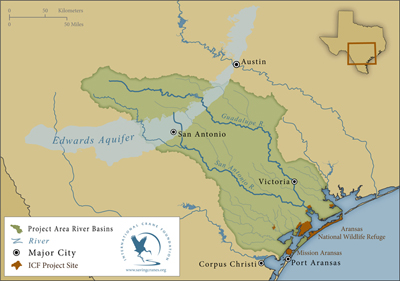| Media Contact: Joan Garland, ICF Outreach Coordinator, 608-381-1262
These updates are prepared by the U.S. Fish and Wildlife Service/Aransas National Wildlife Refuge Complex in eastern Texas, wintering area for the western migratory Whooping Crane population. Learn more about ICF’s committment to Whooping Crane conservation in Texas.
Read the latest update from April 12, 2012 (click here to view all 2011/2012 Whooping Crane Updates from the refuge)
January 23, 2012: This has been a busy month for Whooping Crane activity since our last report. Aransas National Wildlife Refuge has received an additional 0.72 inches of precipitation and salinity levels remain higher than ideal. We have continued to help alleviate the low food resources by adding to our prescribed burn totals. This week alone we have burned an additional 4,682 acres of Whooping Crane habitat. Biologists observed the Whooping Cranes eating roasted acorns and are seeing continued usage (below, photos courtesy of U.S. Fish and Wildlife Service).

The Whooping Crane chick carcass that was sent to the National Wildlife Health Center in Madison, WI last month had inconclusive findings on the intermittent report and we are awaiting the final report, which will include virology results.The latest data from Texas Parks and Wildlife officials indicate that red tide is still persisting in the bays but in lower concentrations. Biologists continue to keep a vigilant watch for signs of illness or disease.Refuge biologists conducted an auto survey on the Blackjack peninsula on December 22, 2011 and observed 45 Whooping Cranes using upland and marsh communities. In addition, aerial survey flights to estimate the Whooping Crane population on wintering grounds has been scheduled the week of January 23rd with the office of Migratory Birds within the U.S. Fish and Wildlife Service. The surveys will consist of three consecutive flights to increase the accuracy of the population estimate. We will post an update when biologists process the flight data.Whooping Cranes observed at the refuge have bright white feathers indicating their overall body condition is good. Despite potential threats this winter, Whooping Cranes continue to thrive and managers are doing everything possible to ensure their continued success.

-
-
-
-
-
-
-
-
-
-
-
-
-
-
The Guadalupe River basin (click on image to enlarge)
|

|



